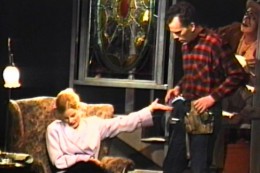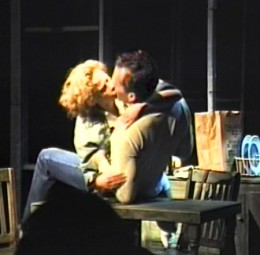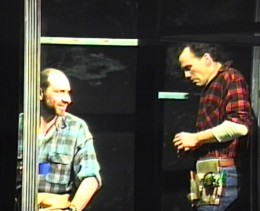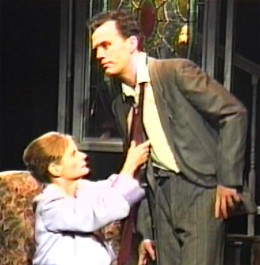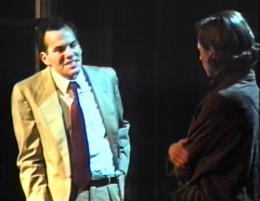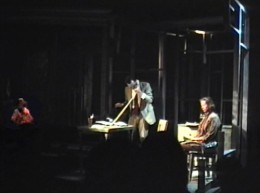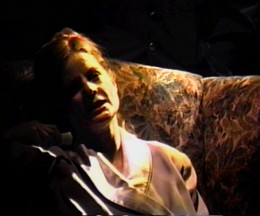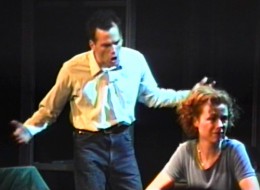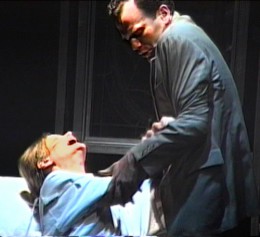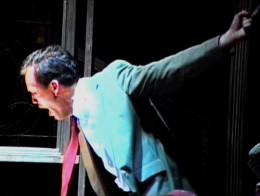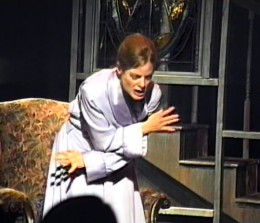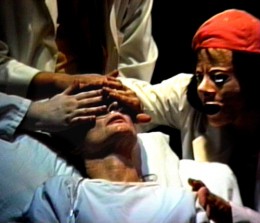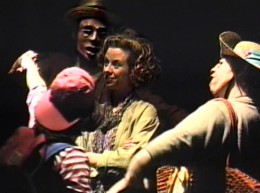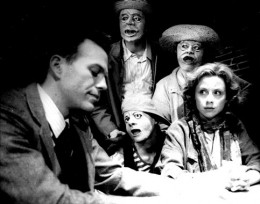Inspired by the true story of the Winchester “Mystery†House in San Jose, CA. An arms heiress is told by a spiritualist that she will live only as long as the sound of construction continues in her house. So for 38 years, 24 hours a day, she employs carpenter crews to expand the house in which she lives as a recluse. A young carpenter goes to work there and spends his life constructing another’s guilt-born obsession. Intersecting the story, on another time plane, are a tour guide and tourists, who are gradually drawn into the terrors of the “Mystery House.â€
Written by Conrad Bishop & Elizabeth Fuller, based on improvisations by The Genesis Ensemble and students of the MFA Theatre Program of Towson State University
Directed by Conrad Bishop, music by Elizabeth Fuller
Designed by Elise Viola
Lighting by Craig Young
Costumes by William Crowther
Full-length; 4m/4w; unit set.
Produced by The Independent Eye in collaboration with Baltimore Theatre Project and Towson University MFA Program, premiering Feb. 28, 1997 at The Theatre Project (Baltimore, MD) and, with a different cast, March 26, 1997, at Old City Stage Works (Philadelphia, PA). Total of 27 performances.
From the program:
Hammers is inspired by the story of Sara Winchester and her construction of a mansion in San Jose, California, begun in 1883 and curtailed at her death in 1922. Today, the Winchester “Mystery†House is a popular tourist attraction.
While the play contains some factual data, the story and the character of “Sophia Weatherlee†are entirely fictitious. For that matter, it’s extremely difficult to separate fact from fantasy in the legend of Winchester House, but that’s true of virtually any historical source. It’s a play about the present, where it’s equally difficult at times to make that distinction.
We look with awe at the Great Pyramid, a gargantuan mausoleum of obsession with death. Since we’re not ourselves on that particular work crew, we pay little mind to the human implications of such monuments. So we invite you on a tour that’s not part of the regular tour. Thanks for coming. We hope you’ve worn the right shoes.
—Bishop & Fuller
—Mark Cofta, Main Line TimesThe Independent Eye continues to create theatrical work of stunning grace and insight, and it’s a shame the plays written, produced, and directed by the team of Conrad Bishop and Elizabeth Fuller aren’t more widely acclaimed.
Hammers, their latest, is inspired by the true story of a woman whose construction of a monstrous mansion began in 1883 and continued for 38 years. . . .
This impeccable production is one of this theater season’s highlights. Take note: great things are happening in the Independent Eye’s tiny 50-seat theater!
—Douglas Keating, The Philadelphia InquirerIf Hammers were just the straight-on story of Sophia Weatherlee, Chuck and Dee it would be pretty conventional theatrical fare, but, like most Independent Eye productions, it is not. Besides the primary characters, there is a group of three tourists, presumably in the future, who are being led through the house by a tour guide. These characters serve as both a satirical commentary on tourism and a means of deepening the production’s eerie atmosphere.
The masked, stereotyped tourists and their weird guide (nicely played by Michael Byrne) become a boorishly behaving, ghoulish Greek chorus, observing and, as the play progresses, increasingly intruding on the scenes of the other characters. When Weatherlee is frightened by the voices and noises she associates with the restless ghosts of the dead, what she hears are tourists roaming her house.
Bishop’s direction strongly limns both the strangeness and the humanity of the play.
—Cary Mazer, Philadelphia City PaperThe past is the future; the house, a cenotaph to memory, is destined to become a mecca for tourists. The voices that Miss Weatherlee hears in the walls are the voices of a Tour Guide and the family of tourists he is escorting, who poke their masked faces and their cameras into the rooms and lives of Miss Weatherlee and her workers, the ghosts of the future haunting the past-haunted present.
There’s another story inhabiting the other rooms of hte play: of Chuck, the blue-collar carpenter turned white-collar foreman and master contractor; Marty, the foreman he displaced; and Chuck’s disgruntled wife Dee. And this story, too, has neglected and dead children, shattered lives, futures haunted by unfulfilled hopes, and lives and bodies lost in the maze and trapped in rooms without exit.
But while I know that the rooms connect, I sometimes felt as though I was lost without a map, abandoned by my tour guides.
I can see how Chuck’s life is boxed in by the obsessive fears of Miss Weatherlee, and how her life is finally boxed in by his. And I can see how Marty’s past becomes Chuck’s future and Chuck’s future becomes the Tour Guide’s past, just as the tourists of the future become the voices of Miss Weatherlee’s past.
But, mapless, I can’t see the master plan, I can’t (on a single viewing) see the structure keeping the rooms from collapsing into the basement. This is, perhaps, because I’m still confused about where my tour guides are asking me to look. The premise of the play (and the magnetic presence of Fuller in the role) tells me that it should be Miss Weatherlee. But the much more interesting stories are those of Chuck (played with obsessive energy by Augustine, who, as in last year’s Mine Alone, plays the most simultaneously likable and despicable blue-collar obsessives in Philadelphia theater) and even, more so, of Dee, whose definition of home (as a place in which you can own a waffle iron) undergoes the greatest set of changes over the course of the play.
But maybe it’s OK to be lost in a play that’s so well-written: to let yourself wander into rooms that seem to lead nowhere, and to be haunted by the characters and their haunted pasts, miserable presents, and inevitable futures.
—Sally Friedman, Bucks County Courier-TimesAt its core, Hammers is really about obsession, and quirkiness run amok. it’s also just as surely about the true cost of meaningless work to a life, about emptiness in more than just rooms, and about the ominous military industrial complex that keeps “rebuilding†itself, moral consequences be damned.
Heavy lifting? You bet.
But believe it or not, there’s also levity in this dark tale, and it’s provided by a kind of masked Greek chorus representing the insatiable curiosity of the worst kind of tourists. The trio saves Hammers from ever taking itself too seriously.
Played with no intermission, this intense and compelling tale is evocative, unsettling and altogether riveting.
Don’t miss this one. It hammers away until it delivers its final knockout punch.
—Wendy Rosenfeld, The Philadelphia WeeklyThe work’s primary relationship follows a carpenter, Chuck Ratowitz, who spends 37 years working for Sophia and diffusing her frequent bouts of hysterical and often hallucinatory panic. From there, the production births connected metaphors lke the sprawling wings of the house itself. Sophia eventually comes to believe she is housing the souls of the war dead—innocents killed by Weatherlee guns. Chuck’s neglected wife, Dee, wants just a waffle iron and her husband to fill her home, but keeps only the iron—even losing their son Joey to the Weatherlee halls when he is killed in battle. As fast as Sophia and Chuck can build the house, its hungry rooms become filled.
Time is no obstacle to the mystery house either; it still claims the souls of those who cannot find the labyrinth’s exit. At the same time Sophia orders yet another wing to be added onto the estate, a trio of masked, gape-mouthed tourists grunt and swarm about the house, their invasiveness tempered only by their fear of discovering the humanity in its inhabitants. The tour guide muses over his reasons for coming to the Winchester house, his own compulsive urges and his trapped life. In Hammers, much as in Tom Stoppard’s Arcadia, a house signifies time’s continuum, and its inhabitants never entirely depart from the space they claim as their own.
